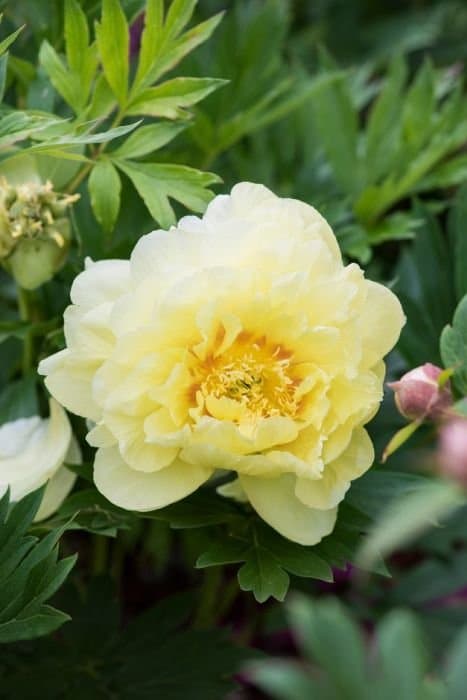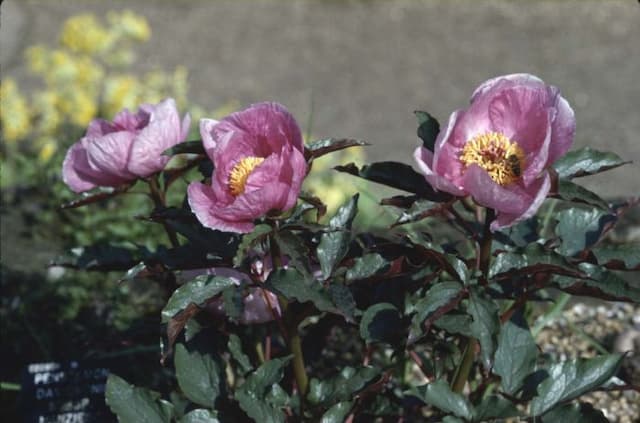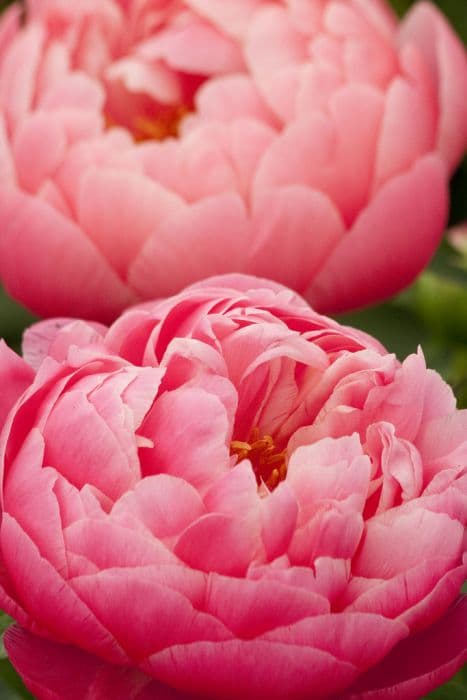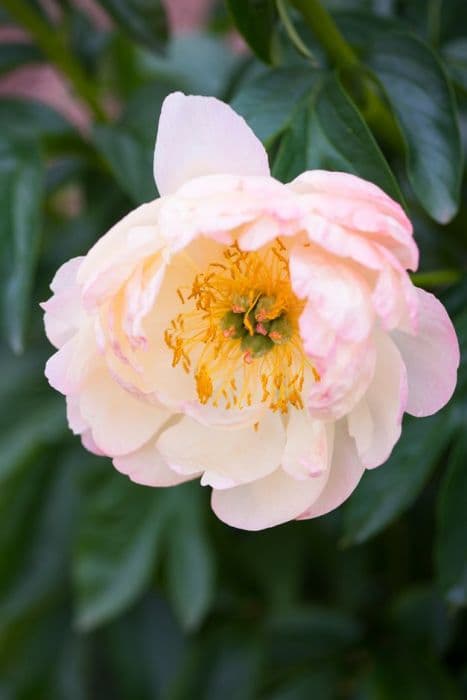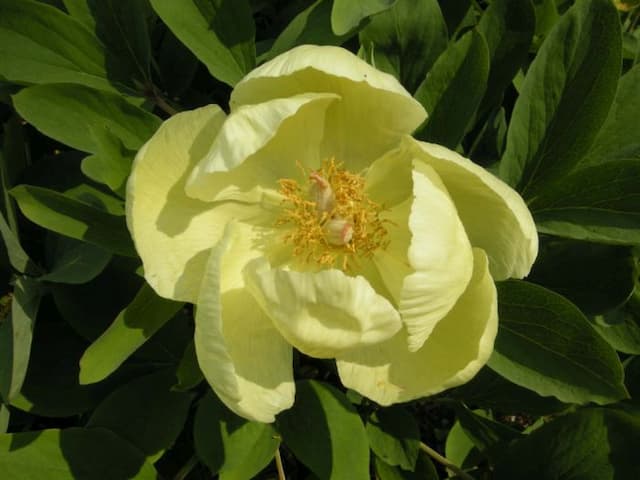Peony Paeonia 'Scarlet O'Hara'

ABOUT
The Paeonia 'Scarlet O'Hara', widely known as Peony 'Scarlet O'Hara', is a visually striking flowering plant known for its vibrant, showy blooms. This particular cultivar boasts large, cup-shaped flowers that demand attention with their bright scarlet-red petals. The vivid color of the flowers is often intensified by a subtle glow from the golden-yellow stamens that peek out from the center, adding a beautiful contrast and depth to the bloom. The peony's blossoms emit a captivating fragrance that can be described as subtly sweet, making it not only a feast for the eyes but also a delight for the senses. The foliage of the Peony 'Scarlet O'Hara' provides a lush backdrop for the bold flowers, with deep green leaves that are glossy and have a leathery texture. The leaves are intricately divided and have a rounded or lance-shaped appearance, forming a bushy, verdant mound that complements the overall grace of the plant. During its blooming period, the plant produces an abundance of flowers, creating a stunning display of red that can become a focal point in any garden or landscape setting. Overall, Peony 'Scarlet O'Hara' presents a captivating combination of color, fragrance, and lush foliage, embodying the classic elegance for which peonies are celebrated.
About this plant
 Names
NamesFamily
Paeoniaceae
Synonyms
Peony, Chinese Peony, Common Garden Peony
Common names
Paeonia 'Scarlet O'Hara'.
 Toxicity
ToxicityTo humans
Peonies, including the Paeonia 'Scarlet O'Hara', are not considered highly toxic to humans. However, they can cause mild gastrointestinal upset if ingested in large quantities. Symptoms might include nausea, vomiting, and diarrhea. It is advised to exercise caution and not consume any parts of the plant.
To pets
Peonies are also not considered highly toxic to pets, but like in humans, ingestion may cause mild gastrointestinal upset. Dogs or cats that consume parts of the peony plant may experience symptoms such as vomiting, diarrhea, and possible drooling. If you believe your pet has ingested a substantial amount of the plant, it would be advisable to consult a veterinarian.
 Characteristics
CharacteristicsLife cycle
Perennials
Foliage type
Deciduous
Color of leaves
Green
Flower color
Red
Height
2-3 feet (0.6-0.9 meters)
Spread
2-3 feet (0.6-0.9 meters)
Plant type
Shrub
Hardiness zones
3-8
Native area
Asia
Benefits
 General Benefits
General Benefits- Attractive to Pollinators: Paeonia 'Scarlet O'Hara' attracts bees and beneficial insects, aiding in the pollination of nearby plants.
- Landscape Beautification: Its bright red flowers and lush foliage add a splash of color and sophistication to any garden setting.
- Aromatic Flowers: The plant emits a pleasant fragrance, which can enhance the sensory appeal of the environment.
- Longevity: Peonies are known for their long lifespan, offering many years of enjoyment once established.
- Seasonal Interest: It provides a striking display in spring when it blooms, marking a highlight in the gardening year.
- Cut Flowers: The blooms make excellent cut flowers for arrangements, bringing the garden's beauty indoors.
- Low Maintenance: Once established, peonies require minimal care beyond occasional watering and fertilizing.
- Drought Tolerance: Mature plants have some level of drought tolerance, reducing the need for frequent irrigation.
- Deer Resistance: Peonies are generally resistant to deer, making them suitable for gardens in areas with high deer populations.
 Medical Properties
Medical PropertiesThis plant is not used for medical purposes.
 Air-purifying Qualities
Air-purifying QualitiesThis plant is not specifically known for air purifying qualities.
 Other Uses
Other Uses- Cut Flower Arrangements: With its bright red blooms, the peony 'Scarlet O'Hara' is often used in floral displays and bouquets, adding a vibrant pop of color and a touch of elegance.
- Wedding Decor: Because of their lush, romantic appearance, peonies are a popular choice for wedding bouquets, centerpieces, and other decorative elements in nuptial celebrations.
- Photography Prop: The striking appearance of peony 'Scarlet O'Hara' flowers makes them a favorite subject for photographers, particularly in spring-themed or botanical photography.
- Artistic Inspiration: Artists may use the bold red petals and lush appearance of the peony 'Scarlet O'Hara' as a muse for paintings, drawings, and other visual art forms.
- Culinary Garnish: Although not commonly consumed, peonies like 'Scarlet O'Hara' can be used as an ornamental garnish for high-end cuisine due to their beauty and impressiveness.
- Perfumery: The scent of 'Scarlet O'Hara' peonies can inspire perfumers to create floral fragrances that capture the essence of a blooming garden.
- Garden Tours: A feature plant in many gardens, 'Scarlet O'Hara' peonies may attract visitors to garden tours and horticultural events.
- Educational Purposes: Horticulture students and enthusiasts may study this plant to learn about hybridization and cultivation techniques associated with peonies.
- Feng Shui: In certain cultures, peonies like 'Scarlet O'Hara' are said to bring good fortune and are used in Feng Shui practices to enhance the energy of a space.
- Crafting: Dried petals of the peony 'Scarlet O'Hara' can be used in crafting for making bookmarks, potpourri, or pressed flower art.
Interesting Facts
 Feng Shui
Feng ShuiThe Peony is used in Feng Shui to attract love and romance, and is often recommended to be placed in the southwest corner of a garden or home to enhance relationship luck.
 Zodiac Sign Compitability
Zodiac Sign CompitabilityThe Peony is not used in astrology practice.
 Plant Symbolism
Plant Symbolism- Prosperity: Peonies are often associated with wealth and good fortune.
- Honor: They embody honor and high esteem, perhaps due to their regal bearing and full blooms.
- Romance: With their lush, full, rounded bloom, peonies embody romance and love, and are often used in wedding bouquets.
- Beauty: The peony, especially the striking 'Scarlet O’Hara', represents unmatched beauty.
- Compassion: Some cultures connect peonies with compassion and empathy, celebrating their soft and delicate nature.
- Good Luck: In some traditions, peonies are believed to bring good luck, especially in terms of marriage and relationships.
 Water
WaterPeonies, such as 'Scarlet O'Hara', should be watered deeply once a week if there is no significant rainfall, providing about one gallon of water per plant. During the growing season, especially if the weather is particularly dry or hot, the frequency may increase to twice a week. It's important to avoid overhead watering to prevent fungal diseases; instead, water at the base of the plant. The soil should be allowed to dry out slightly between waterings, and it's crucial not to overwater as peonies do not like wet feet, which can lead to root rot.
 Light
LightPeonies like 'Scarlet O'Hara' thrive in full sun, needing at least 6 to 8 hours of direct sunlight daily to bloom properly. An ideal spot would be in a garden area that receives morning sun and is protected from the intense heat of the late afternoon sun. Partial shade is acceptable, especially in hotter regions, but too much shade can reduce flowering.
 Temperature
TemperaturePeonies such as 'Scarlet O'Hara' prefer temperate climates with cold winters; the ideal temperature range for their growth is between 65°F and 75°F during the day. They require a chilling period at below 40°F to set buds for the following spring and can generally tolerate winter temperatures down to about -20°F. High temperatures above 85°F might inhibit blooming and cause the plant to go dormant early.
 Pruning
PruningPeonies such as 'Scarlet O'Hara' should be pruned to remove any dead or diseased wood, and to shape the plant if desired, usually after flowering in summer. Pruning in the fall is also essential; trim the stems down to just above ground level after the first frost to help prevent disease. These plants require minimal pruning beyond removing spent flowers and deadheading to encourage a tidy appearance.
 Cleaning
CleaningNot needed
 Soil
SoilPeonies like well-drained, fertile soil with a neutral to slightly acidic pH between 6.5 and 7.0. A mix of two-thirds garden soil and one-third compost or well-rotted manure, with a handful of granular all-purpose fertilizer, will create an ideal environment for the Peony 'Scarlet O’Hara'.
 Repotting
RepottingPeonies, including 'Scarlet O'Hara', are long-lived perennials and typically do not require frequent repotting. They should only be transplanted or divided if necessary, about every 10 to 15 years, as they prefer not to be disturbed.
 Humidity & Misting
Humidity & MistingPeony 'Scarlet O'Hara' prefers average humidity levels and does not require any special humidity considerations. It is generally tolerant of the humidity levels found in most climate zones where it thrives outdoors.
 Suitable locations
Suitable locationsIndoor
Peonies, like 'Scarlet O'Hara', do not thrive indoors; best to plant outdoors.
Outdoor
Plant in full sun to part shade, fertilize annually, and ensure well-drained soil.
Hardiness zone
3-8 USDA
 Life cycle
Life cycleThe life cycle of the Peony ‘Scarlet O’Hara’ begins with seed germination, which takes place under favorable conditions of moisture and temperature. After germination, the plant enters a vegetative growth phase, where it develops a root system, foliage, and stems over several years before it reaches maturity. Once mature, the peony produces large red flowers typically in late spring or early summer, a process which continues yearly once the plant is established. After flowering, the plant sets seed in the form of a capsule that, once matured, opens to release seeds. In the autumn, the peony's above-ground foliage dies back and the plant enters a period of dormancy, drawing energy from the tuberous root system to survive the winter. With the return of spring, the cycle repeats as the plant emerges from dormancy to grow and bloom again.
 Propogation
PropogationPropogation time
Spring-Early Summer
Propogation: The Paeonia 'Scarlet O'Hara', commonly known as Peony, is best propagated through division during the fall, after the plant has gone dormant and the leaves have died back. To divide peonies, dig up the entire plant, making sure to get as much of the root system as possible. Gently shake off excess soil and use a sharp knife to divide the root clump into sections, ensuring that each section has at least 3-5 eyes, which are the pink or white buds that will become next year's shoots. Replant each division promptly, setting the eyes no more than 2 inches deep (approximately 5 centimeters) in well-draining soil, as planting them too deep can prevent blooming. Water thoroughly after planting to settle the soil around the roots.
